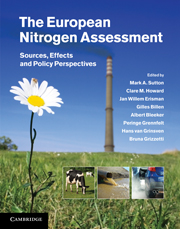Book contents
- Frontmatter
- Contents
- List of contributors
- Foreword
- Summary for policy makers
- Technical summary
- 1 Assessing our nitrogen inheritance
- Part I Nitrogen in Europe: the present position
- Part II Nitrogen processing in the biosphere
- Part III Nitrogen flows and fate at multiple spatial scales
- Part IV Managing nitrogen in relation to key societal threats
- Part V European nitrogen policies and future challenges
- Glossary
- Index
Foreword
Published online by Cambridge University Press: 16 May 2011
- Frontmatter
- Contents
- List of contributors
- Foreword
- Summary for policy makers
- Technical summary
- 1 Assessing our nitrogen inheritance
- Part I Nitrogen in Europe: the present position
- Part II Nitrogen processing in the biosphere
- Part III Nitrogen flows and fate at multiple spatial scales
- Part IV Managing nitrogen in relation to key societal threats
- Part V European nitrogen policies and future challenges
- Glossary
- Index
Summary
Addressing the grand challenges of society depends fundamentally on firm scientific evidence. Today, Europe faces several of these challenges, as outlined in the Europe 2020 strategy adopted by the Commission on 3 March 2010, including climate change, energy and food security, health and an ageing population. Research and innovation are crucial to address these challenges effectively. For that reason, the Commission launched the ‘Innovation Union’ flagship initiative, with the aim to re-focus research and development as well as innovation policy on these grand societal challenges.
In this framework we very much welcome the European Nitrogen Assessment. It is fair to say that nitrogen will be a new story for many people. Yet we can here clearly identify a case of science at its best: innovative thinking that enables the development of connections from evidence-based policies to evidence-tested decisions.
The Assessment highlights how human production of reactive nitrogen has literally changed the world. Since the invention of the Haber-Bosch process a century ago, humans have been able to double the world's circulation of nitrogen compounds, resulting in nitrogen fertilizers sustaining around 3 billion people, almost half of the world population. It is therefore obvious that nitrogen is essential, not only to meeting the challenge for food security, but, with the increasing importance of biofuels, also for energy security.
- Type
- Chapter
- Information
- The European Nitrogen AssessmentSources, Effects and Policy Perspectives, pp. xxiiiPublisher: Cambridge University PressPrint publication year: 2011



